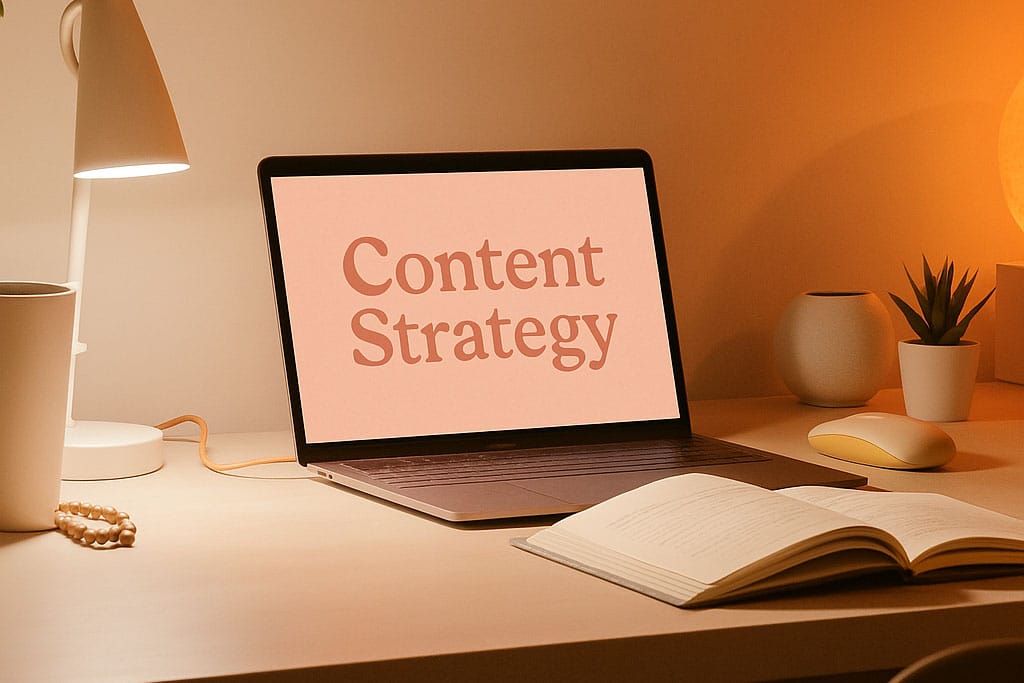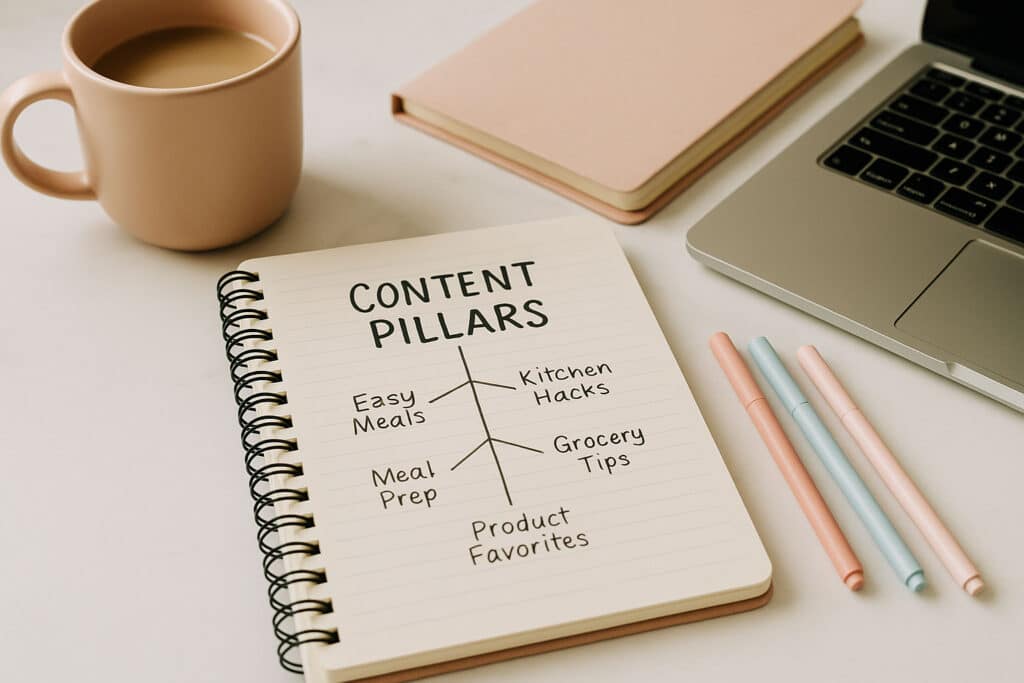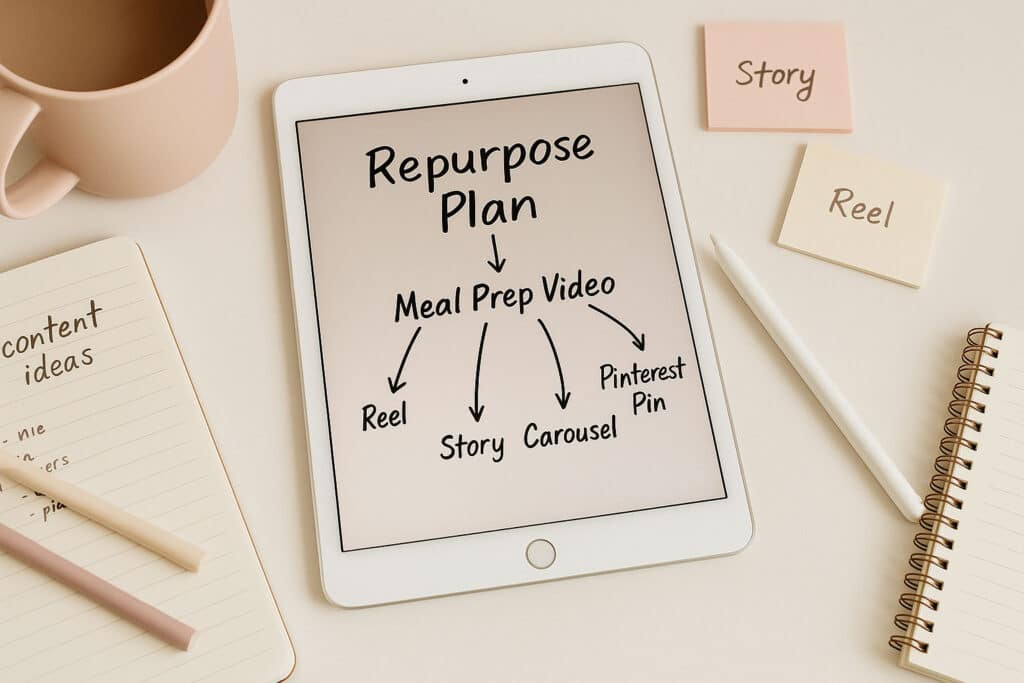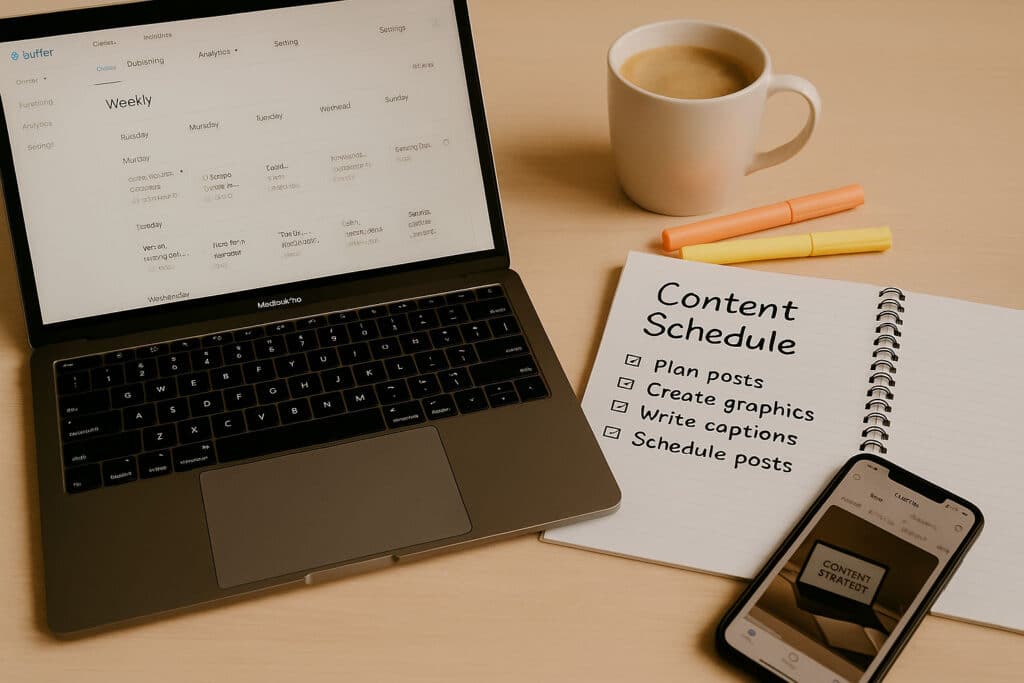How to Optimize Your Content Strategy (Without the Burnout)
If you’re tired of feeling like you’re always chasing the next post, you’re not alone. I have been there, and social media can feel overwhelming, especially without a system. A strong, optimized content strategy is the key to showing up with purpose and protecting your time and energy along the way.
Whether you’re a blogger, small business owner, or aspiring content creator, I created this guide to help you simplify your process, maximize your efforts, and finally feel in control of your content calendar.

Why Your Content Strategy Feels Chaotic (and How to Fix It)
If you’re anything like me, I don’t struggle with ideas, I struggle with organization.
What leads to burnout isn’t a lack of creativity, it’s constantly scrambling to figure out what to post, where, and when. But here’s the good news: you don’t need a full-time team or expensive software to fix this. I have done this on my own to this point (with some help from my husband on the technical side).
You just need a clear strategy — and a few tools to keep it flowing.
Content Strategy Tools to Make Life Easier
Content Planning & Organization
- Airtable – A flexible content calendar tool with drag-and-drop ease and templates for creators
https://airtable.com (This is the number 1 tool I have opened daily!) - Google Sheets – Free and collaborative spreadsheet for content planning and tracking
https://sheets.google.com - Notion – All-in-one workspace to organize ideas, goals, and your full editorial process
https://notion.so - Trello – Visual card-based planner that works great for blog post and social media scheduling
https://trello.com - Microsoft Excel – Classic spreadsheet tool for offline editorial calendars or KPI tracking
Scheduling & Social Media Management
- Buffer – Simple and clean social media scheduler with analytics (This is what I am currently using at its amazing!!) https://buffer.com
- Later – Instagram-first planner that also supports TikTok, Pinterest, and Facebook
https://later.com - Planoly – Drag-and-drop visual planner with Instagram grid previews
https://planoly.com - Hootsuite – Enterprise-ready scheduler with advanced analytics and bulk scheduling
https://hootsuite.com
Bonus Tools for Repurposing & Optimization
- Canva – Easily create branded graphics, carousels, and pins (Love, Love, Love Canva)
https://canva.com - CapCut – Free mobile and desktop video editor perfect for TikTok & Reels
https://capcut.com - ChatGPT – Generate caption ideas, brainstorm content pillars, or refine blog copy
https://chat.openai.com
Step 1: Choose Your Core Topic + Supporting Topics (Create Content Pillars)
Instead of boxing yourself into a tiny niche, build a flexible content structure.
- Pick 1 Core Topic — The main focus of your brand or business (ex: easy meals, wellness, clean beauty)
- Choose 3–5 Supporting Topics (Content Pillars) — Related areas that offer variety without straying from your brand
Example:
- Core: Quick Weeknight Dinners
- Supporting: Meal prep tips, grocery hacks, favorite kitchen tools, behind-the-scenes blog life
This keeps your message clear, your content engaging, and your creativity refreshed.

Step 2: Map out a Simple Posting Plan
Consistency beats perfection every time, but it only works if it’s something you can actually stick to.
When building your content plan, think of it as a rhythm, not a rigid calendar. Use tools like Airtable or a simple spreadsheet to map out your week and balance your content pillars across your chosen platforms.
Know When Not to Post
It’s not just about what you post, it’s about when you post it. Every niche has better and worse days for engagement. Doing a little research here can help you stop wasting great content on low-engagement days and give yourself permission to take strategic breaks.
- If you’re in B2B or business-focused niches, Fridays tend to perform poorly.
- But if you’re in lifestyle, food, fashion, or entertainment, Fridays and weekends often do great — and Mondays are usually the slowest.
So, instead of pushing yourself to post daily, schedule your high-impact content on high-performing days — and take off the low days to batch, rest, or plan.
Sample Weekly Plan (for lifestyle or food niches):
| Day | Content Type | Topic |
| Tuesday | Reel or TikTok | 10-Minute Dinner Hack |
| Wednesday | Carousel or Story | Favorite Pantry Staples |
| Friday | Static Post | Friday Favorites (Products) |
The goal is to build a realistic, repeatable system that helps you stay consistent, not burnt out

Step 3: Repurpose One Idea into Five Piece of Content
Let’s work smarter, not harder.
Every content idea has multiple angles. With one shoot or brainstorming session, you can create several valuable posts.
Example for a meal-prep theme:
- Quick intro video — Planning your grocery list
- Step-by-step tutorial — Prepping meals in action
- Mini tip post — Favorite containers or storage hacks
- Comment reply — Answering a common question
- Photo dump or carousel — Behind-the-scenes of prep day
This saves time and gives your audience more ways to engage.
Step 4: Match Your Content to the Right Platform
Not all content belongs everywhere.
Different platforms serve different purposes, so tailor your posts accordingly:
- Instagram: Aesthetic Reels, carousels, and community engagement
- TikTok: Raw, unfiltered storytelling and quick tutorials
- Pinterest: Visual idea pins, infographics, blog links
- Blog: Long-form, SEO-rich content that lasts
And don’t forget to cross-promote, mention your latest blog post in a Reel or link your TikTok in an Instagram caption.

Step 5: Schedule Your Posts to Stay Consistent
If you’re constantly trying to post in real-time, you’ll always feel behind.
Instead, use a tool like Buffer.com to schedule your posts across platforms, all from one dashboard. Batch your content, queue it up, and let it run while you focus on creating, connecting, or just catching your breath.
Buffer also provides insights so you can see what’s working and tweak your strategy over time.
Final Thoughts: Build a Strategy That Feels Good (and works)
An optimized content strategy doesn’t mean doing more. It means doing what works, better.
By choosing strong content topics, creating a plan that fits your life, repurposing smartly, and scheduling ahead with tools like Airtable and Buffer, you’ll finally feel less overwhelmed and more in control.
No more last-minute panic. Just content that’s clear, aligned, and sustainable.
Want more creator tools and tips?
Make sure to follow us on Pinterest or explore some of favorite planning tools above!
